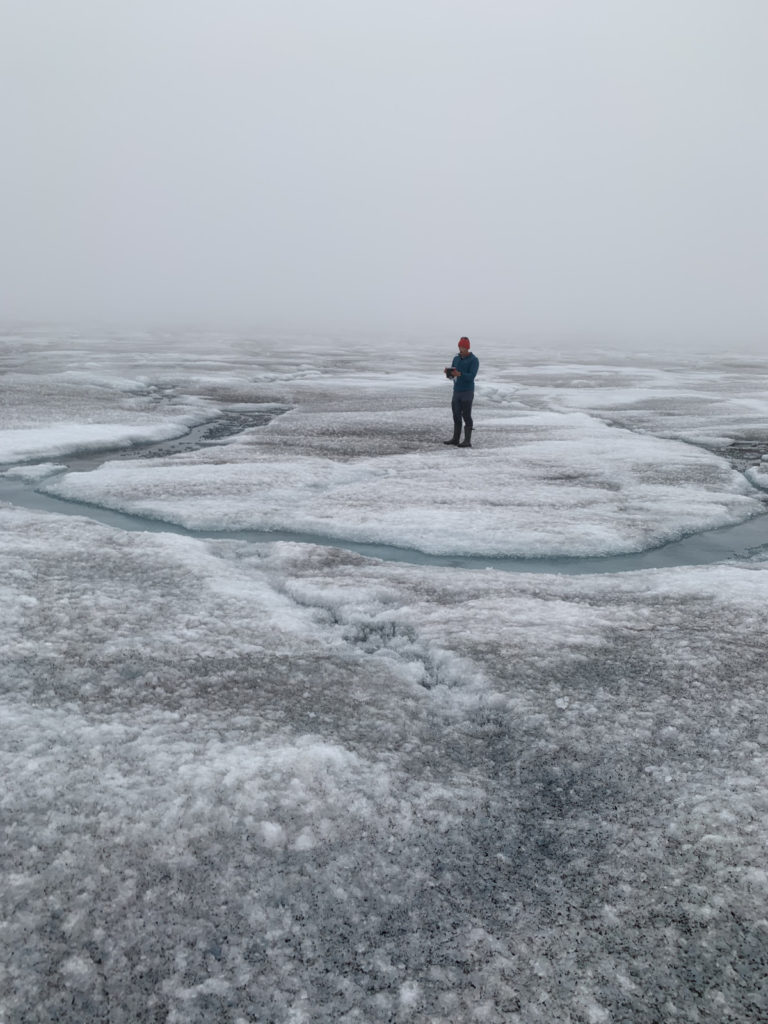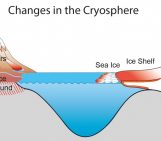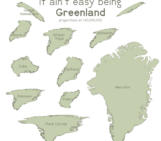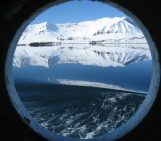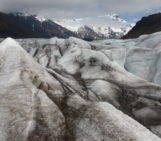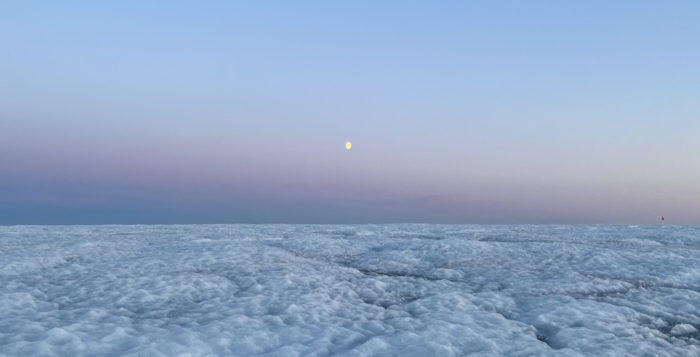
To the untrained eye, the melting surface of glaciers and ice sheets can look a little boring. It’s bright in some places, dark in others, and there are lots of things to fall over and (hopefully not) get your feet wet in. However, a huge range of processes are occurring both upon and just underneath the ice surface, in a 50-ish cm thick layer of ice called the weathering crust (or the “crust” for short). The crust has traditionally been ignored by glaciologists but is a crucial element of the glacial hydrological system. It houses an active microbial community and is a key player in the darkening of ice surfaces – so to get you acquainted, here is a short beginner’s guide.
Ice doesn’t just melt at the surface…
…but also just below the surface, which is how the weathering crust forms. First, we need to recap what makes up glacier ice. Rather than being one solid block, it is an amalgamation of small crystals which started out their lives as snowflakes which were squashed under pressure. Or, more technically, glacier ice is a polycrystalline solid. When sunlight hits this surface, the energy is either reflected (when the albedo of the surface is high), absorbed, or penetrates into the ice sub-surface. This sunlight can, in theory, reach depths of 2 m, but in reality, the presence of water, air and other impurities makes this number much lower (more like 50-ish cm). Like on the surface, energy absorbed in the near-surface causes melting. This occurs preferentially on the edges of individual ice crystals, creating and enlarging void space between them. This weathering, or so-called “rotting”, of the ice is characteristic of the crust and can be measured as a change in bulk ice density. Weathered ice can have a density as low as 300 kg m-3 – similar to ground coffee (or milk powder, if you have been to field camp this summer), or around one-third of the density of unweathered glacial ice.
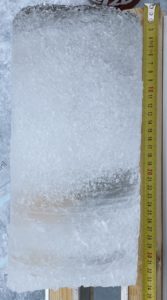
A shallow (approximately 20-25 cm) section of weathering crust ice extracted from its natural habitat. Note the change in ice colour from white to clear. Photo credit: Ian Stevens
The weathering crust is constantly changing
For a nice, thick (50-ish cm) weathering crust to form, there is one crucial ingredient: sunshine! Whilst it would be great to live 100% of the time in the sun, it doesn’t always happen, and like most of us, the weathering crust starts to degrade with a lack of sunshine. When the crust receives less sunlight (due to cloud cover or overnight), the turbulent energy fluxes (direct transfer of energy between the air and the ice) become the dominant source of energy for melting. This is bad news for the crust, as these conditions remove weathered ice and thin the crust. Rainfall further accelerates this process and can often completely strip the crust away, revealing the blue, unweathered glacier ice below in a matter of hours. Diurnal cycles and changes in weather mean the crust is constantly changing throughout the melt season.
There’s a lot of water under the surface
Melted glacier water needs to go somewhere, and it ends up in the weathering crust. The crust acts as a “perched aquifer”, with the unweathered ice at the base of the crust acting as an impermeable barrier or aquiclude. Much like a groundwater system, meltwater percolates through the unsaturated ice nearest the surface, before reaching the saturated ice below. This water table is commonly found at depths of 10-20 cm. Water flows laterally through the saturated ice, driven by the hydraulic gradient at a rate of up to 1 m/day before entering the surface stream network.
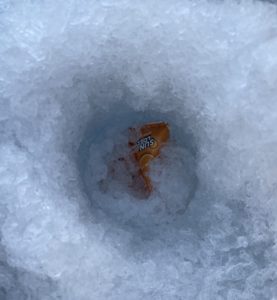
The unsaturated upper layer of the weathering crust (sun lolly for “scale”, definitely not a failed field ice-cream experiment). Photo credit: Ian Stevens.
Where there is water, there are microbes
And lots (between ten thousand and one million cells per mL of melt water) of them! Within the crust, there is a vast range of habitats; hydrologically-connected cryoconite holes, the surfaces of ice crystals, and the water within the weathering crust. The microbes include algae and bacteria which actively cycle carbon and nitrogen and darken the ice surface, reducing its albedo. Microbes within the crust’s water are transported into surface channels, and then downstream into riverine, terrestrial and marine environments. Despite this, recent work shows that biomass, and therefore carbon, is stored within the crust throughout the melt season. However, like many phenomena associated with the weathering crust…
…we don’t actually know all that much
Whilst this post may make it seem like we have some idea of what goes on in the crust, there is still a lot we don’t know. Some of the research avenues currently being investigated are:
- Explore controls on weathering crust formation and degradation through the collection of numerical datasets and the development of models
- Establish robust links between the physical properties of the crust and both surface and sub-surface albedo
- Understand flow pathways and residence times of water and microbes
- Outline the connections and feedbacks between the physical properties of the weathering crust and its microbial biogeochemistry
As a picture paints 1000 words (and I have used more than my fair share), all of this can be summed up in one figure:
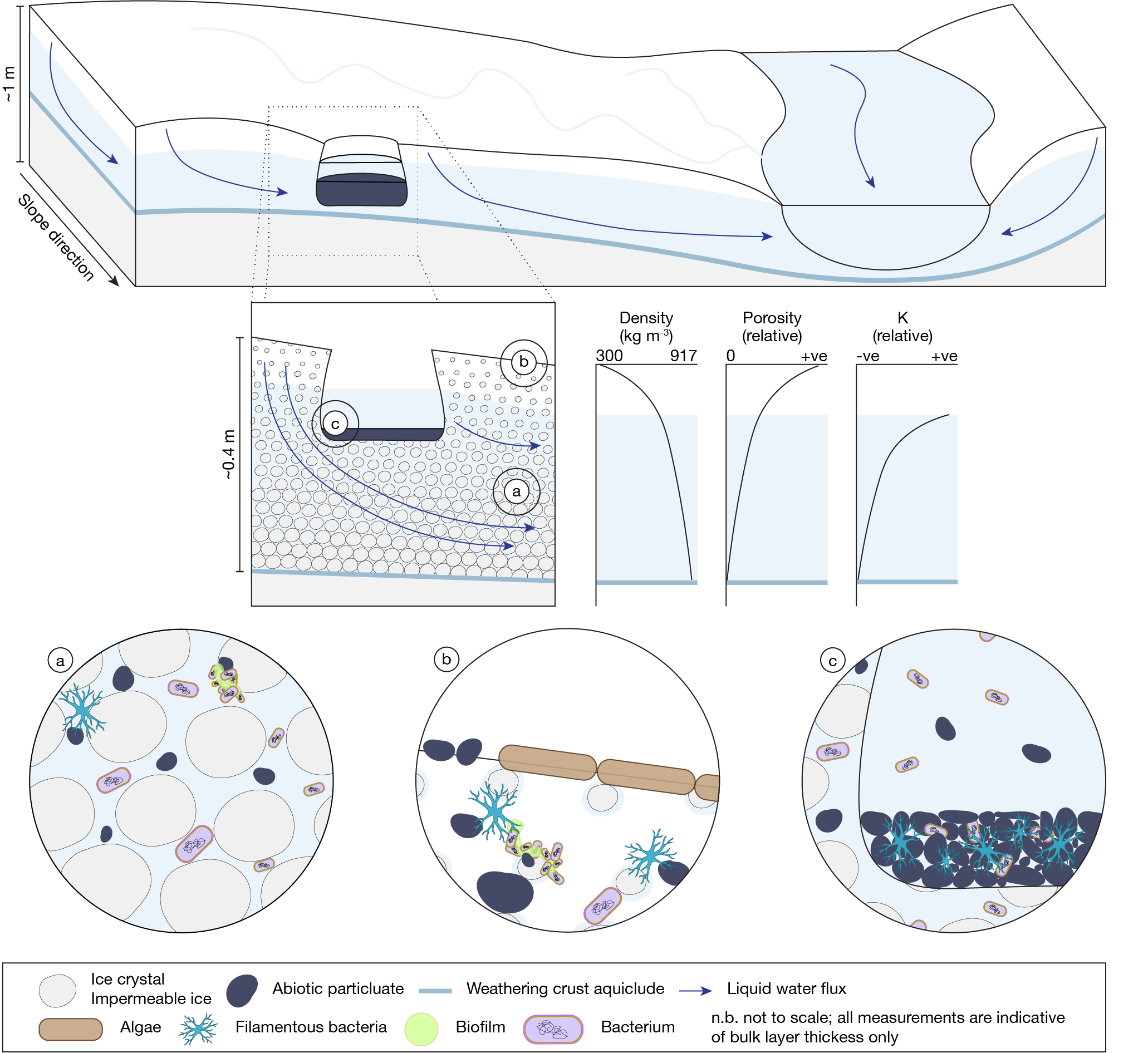
A summary schematic of the weathering crust. The upper panel shows a cross-section through the ice and water flowing across and beneath the ice surface. The three graphs show how ice density, porosity and hydraulic conductivity vary with depth in the upper 0.5 m of ice. Panels a, b and c show a range of microbial habitats: a portrays the saturated weathering crust zone; b illustrates the “surface” ice-air interface where glacier ice algae thrive; and c represents a cryoconite hole ecosystem that punctuates the weathering crust. Microbes and biofilms suspected to be present in each environmental niche are indicated. Figure credit: Ian Stevens
Further reading
- Cook, J.M., Tedstone, A.J., Williamson, C., McCutcheon, J., Hodson, A.J., Dayal, A., Skiles, M., Hofer, S., Bryant, R., McAree, O. and McGonigle, A., 2020. Glacier algae accelerate melt rates on the south-western Greenland Ice Sheet. The Cryosphere, 14(1), pp.309-330.
- Irvine-Fynn, T.D., Edwards, A., Stevens, I.T., Mitchell, A.C., Bunting, P., Box, J.E., Cameron, K.A., Cook, J.M., Naegeli, K., Rassner, S.M. and Ryan, J.C., 2021. Storage and export of microbial biomass across the western Greenland Ice Sheet. Nature Communications, 12(1), pp.1-11.
- Müller, F. and Keeler, C.M., 1969. Errors in short-term ablation measurements on melting ice surfaces. Journal of Glaciology, 8(52), pp.91-105.
- Stevens, I.T., Irvine‐Fynn, T.D., Porter, P.R., Cook, J.M., Edwards, A., Smart, M., Moorman, B.J., Hodson, A.J. and Mitchell, A.C., 2018. Near‐surface hydraulic conductivity of northern hemisphere glaciers. Hydrological Processes, 32(7), pp.850-865.
- DEEP PURPLE
- More about Cryoconite holes in a previous Cryoblog
Edited by Jenny Arthur and Marie Cavitte
 Ian Stevens is a postdoc at Aarhus University, Denmark, working on the ERC Synergy Grant DEEP PURPLE. He investigates the physical properties, hydrology and microbiology of the weathering crust and the meltwater contained within it. He tweets sporadically as @theianstevens, or can be emailed at ian.stevens@envs.au.dk
Ian Stevens is a postdoc at Aarhus University, Denmark, working on the ERC Synergy Grant DEEP PURPLE. He investigates the physical properties, hydrology and microbiology of the weathering crust and the meltwater contained within it. He tweets sporadically as @theianstevens, or can be emailed at ian.stevens@envs.au.dk

